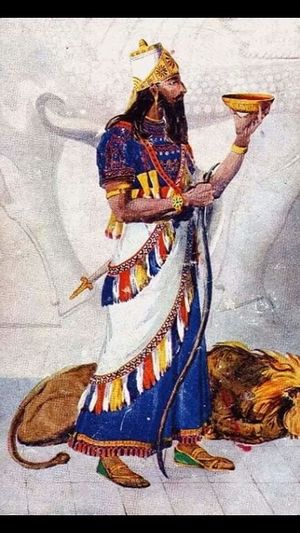Nabopolassar
| Nabû-apla-usur | |
|---|---|
| King of Babylon | |
| Reign | ca. 626 – 605 BC |
| Predecessor | Ashur-uballit II |
| Successor | Nebuchadnezzar II |
| Born | ca. 658 BC |
| Died | ca. 605 BC |
Nabopolassar (/ˌnæbɵpəˈlæsər/; Akkadian: Nebû-apal-usur; c. 658 BC – 605 BC) was a king of Babylonia and a central figure in the fall of the Assyrian Empire following the death of the last powerful Assyrian king, Ashurbanipal.[1] Ashurbanipal had appointed Kandalanu to oversee Babylon during his reign, but his disappearance in 627 BC led to political instability. In 626 BC, a native dynasty arose under Nabopolassar, a former Assyrian official. Nabopolassar made Babylon his capital and ruled over Babylonia for a period of about twenty years (626–605 BC). He is credited with founding the Neo-Babylonian Empire, also known as the Akkadian Dynasty. By 616 BC, Nabopolassar had united the entire area under his rule.[2]
Military campaigns and life achievements
Nabopolassar revolted against the Assyrian Empire (which had ruled Babylon for the previous 200 years) after the death of the last effective Assyrian king, Ashurbanipal, and claimed the throne of Babylon in 626 BC.
During Nabopolassar's reign, there was a boom of Neo-Babylonian building projects that would continue through the reign of his son, Nebuchadnezzar II. Temples and ziggurats were repaired or rebuilt in almost all the old dynastic cities, while Babylon itself was enlarged and surrounded by a double enceinte, or line of fortification, consisting of towered and moated fortress walls. The first mention of Neduchadnezzar II comes from the records of Nabopolassar, saying he was a laborer in the restoration of the temple of Marduk.[3]
Assyria, weakened by internal strife and ineffectual rule following the death of Ashurbanipal, was unable to resist the alliance of the Medes, who united to sack the Assyrian capital of Nineveh in 612 BC. Following a prolonged siege at the Battle of Nineveh, Nabopolassar took control of the city. In 609 BC, Nabopolassar captured the Assyrian city of Harran, where Assyrian forces had retreated after the fall of Nineveh. From 610 BC until his death, Nabopolassar also fought the Egyptians, who were allied with Assyria.
A cylinder found in 1921 in Baghdad, Iraq attributes itself to Nabopolassar. He is described therein as extremely pious, and that he "sought out the temples... and the complete performance of their rites." He attributes his success to Shazu (one of the names associated with Marduk[4]). Throughout the inscription, Nabopolassar describes some of his greatest military conquests and submits himself to Marduk and other deities. [5]
Once his forces had defeated the Assyrians, Nabopolassar promised his throne to Nebuchadnezzar. In 605 BC, his son Nebuchadnezzar fought Pharaoh Necho II of Egypt and the remnants of the Assyrian army at the Battle of Carchemish. Within months of his abdication in 605 BC, Nabopolassar died of natural causes at about 53 years of age, and Nedbuchanezzar II hurried to Babylon to secure the throne.[6]
See also
References
Cite error: Invalid <references> tag;
parameter "group" is allowed only.
<references />, or <references group="..." />External links
- http://www.britannica.com/EBchecked/topic/401320/Nabopolassar
- ABC 2: Chronicle Concerning the Early Years of Nabopolassar
- ABC 3: Chronicle Concerning the Fall of Nineveh
- ABC 4: Chronicle Concerning the Late Years of Nabopolassar
- Nabopolassar Cylinder
| Preceded by Kandalanu |
King of Babylon 626–605 BC |
Succeeded by Nebuchadnezzar II |
- ↑ D. Brendan Nagle, The Ancient World: A Social and Cultural History, 6th ed., Upper Saddle River, N.J.: Pearson, 58.
- ↑ Van De Mieroop, Marc. 2007. A history of the ancient near east ca. 3000-323 Blackwell Publishing.
- ↑ http://www.britannica.com/EBchecked/topic/376897/Mesopotamian-art-and-architecture/37867/Painting-and-decorative-arts#ref420027
- ↑ The Fifty Names of Marduk
- ↑ http://www.kchanson.com/ANCDOCS/meso/nabo.html
- ↑ Van De Mieroop, Marc. 2007. A history of the ancient near eastBlackwell Publishing.
